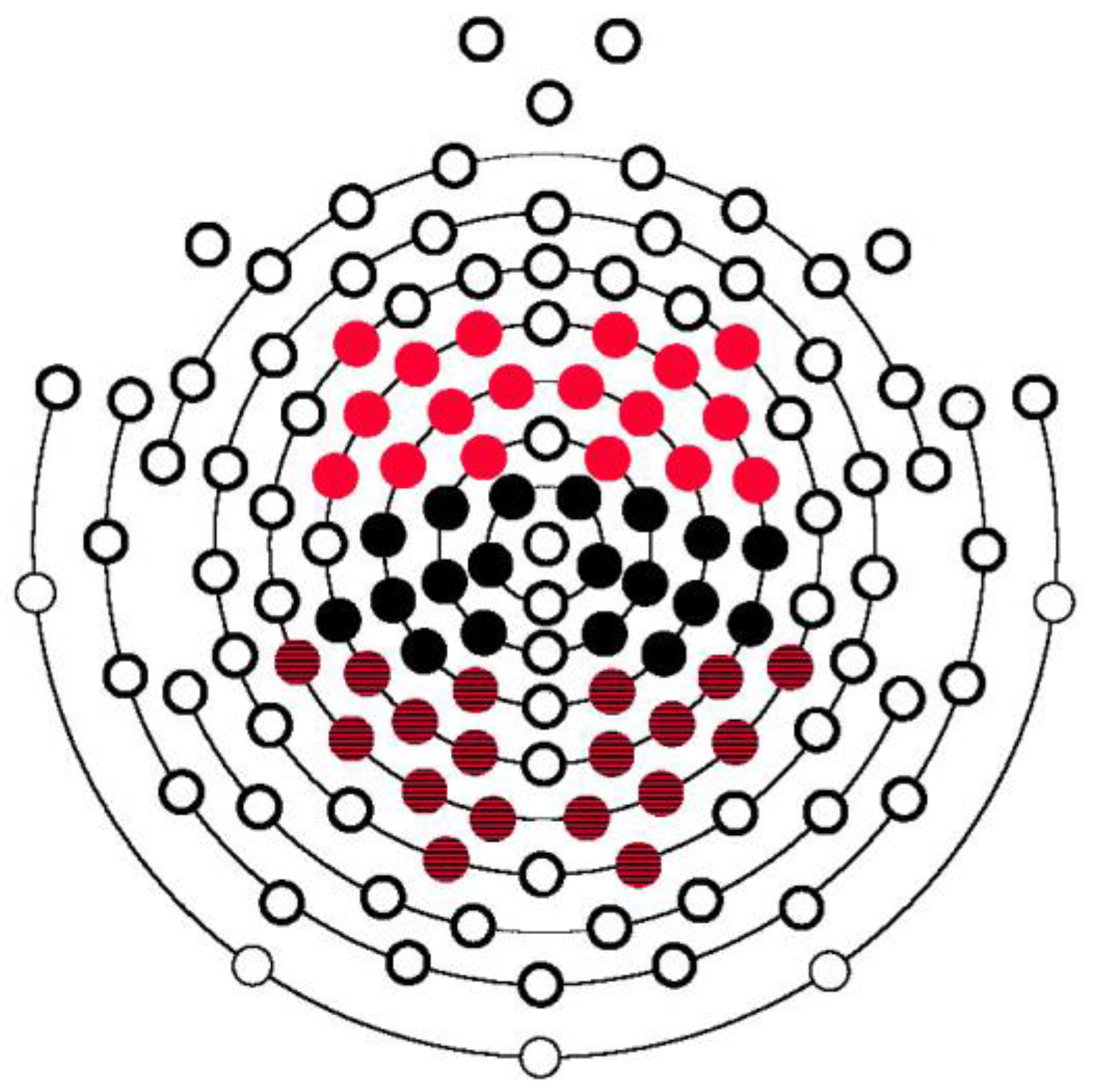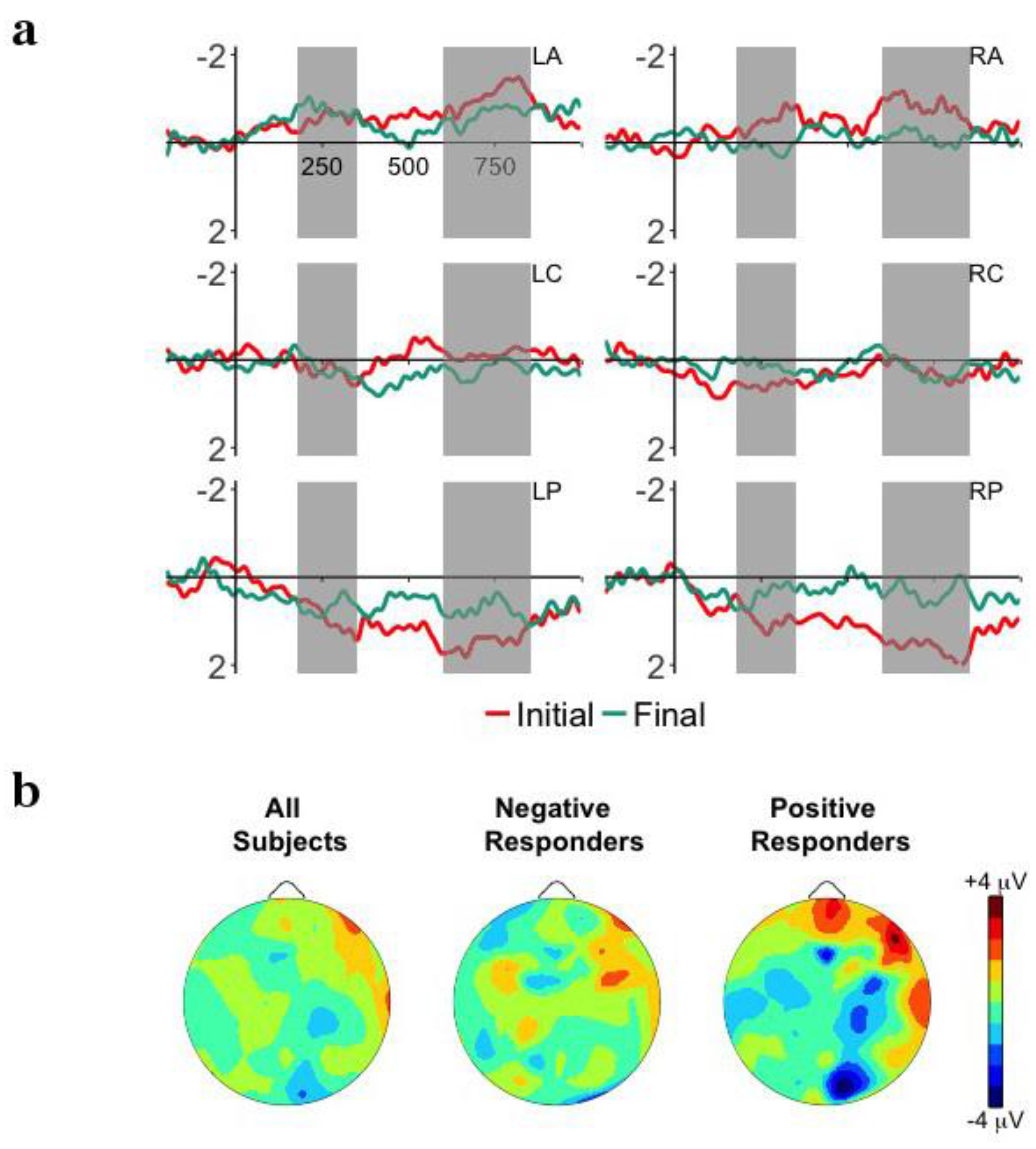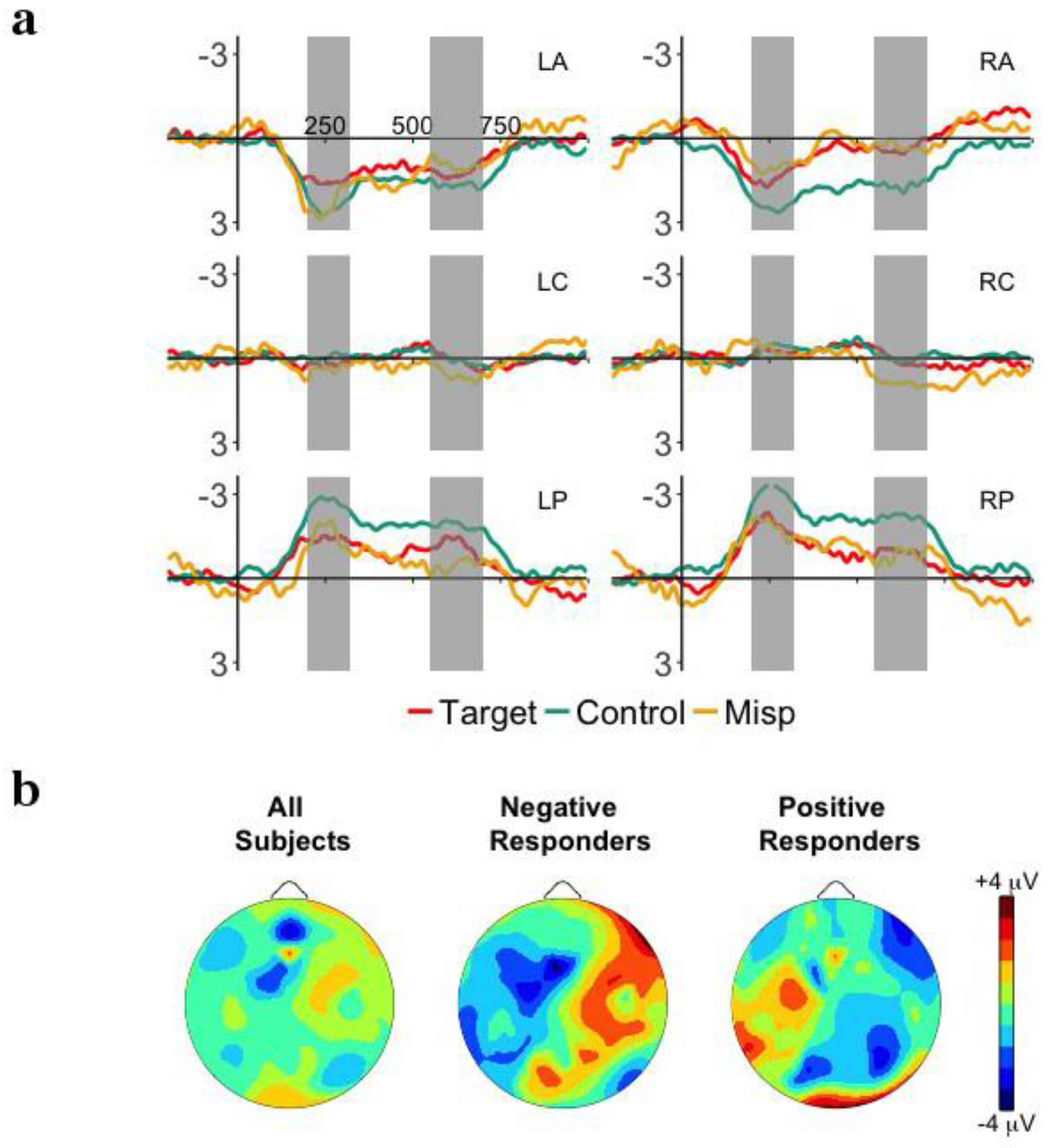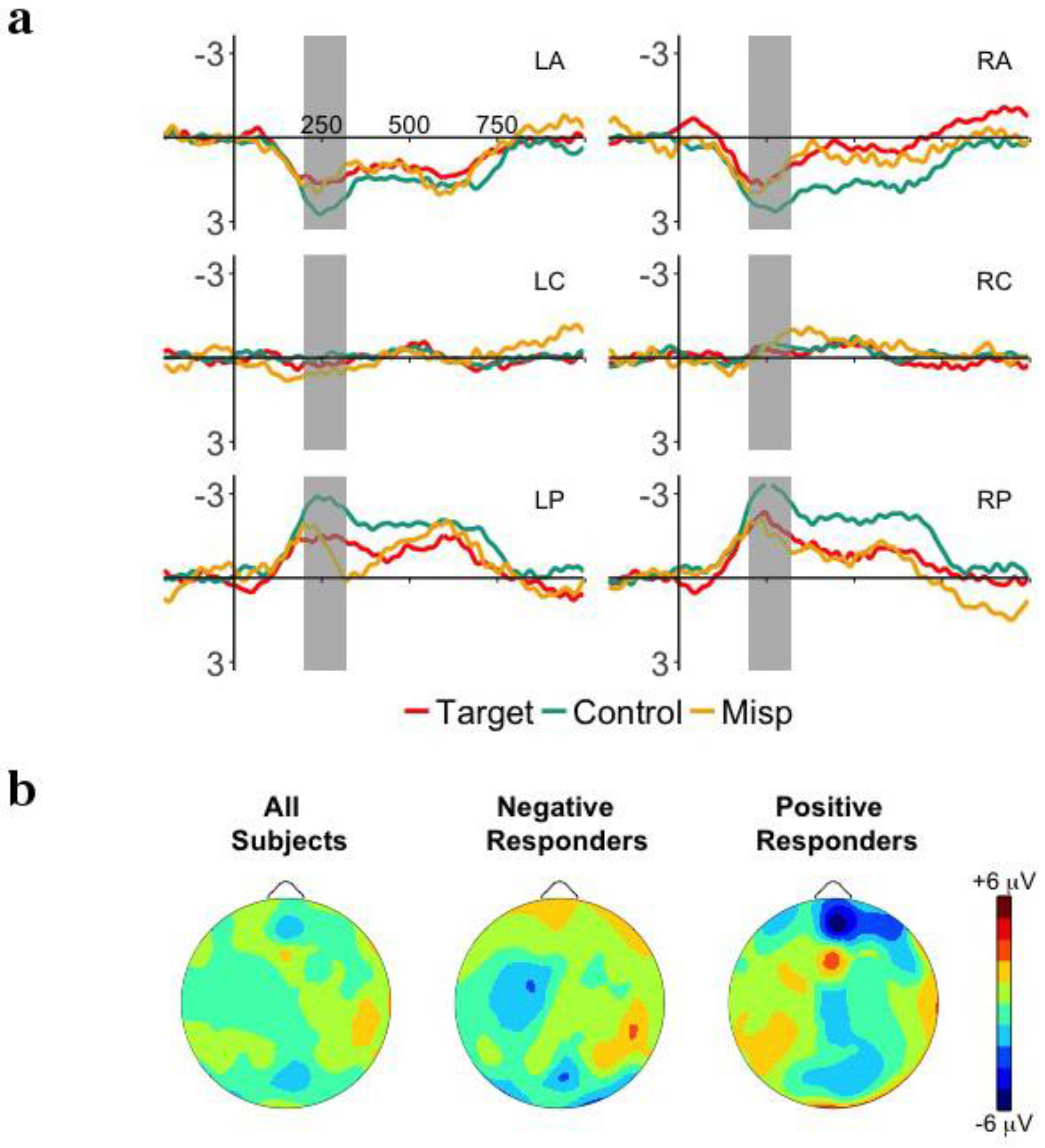Consonant and Vowel Processing in Word Form Segmentation: An Infant ERP Study
Abstract
:1. Introduction
2. Materials and Methods
2.1. Participants
2.2. Stimuli
2.3. Procedure
2.4. Vocabulary Questionnaire
2.5. EEG Recording and Preprocessing
2.6. ERP Data Analysis
3. Results
3.1. Familiarization Phase: Memory Trace Formation
3.2. Test Phase: Word Familiarity Effect
3.3. Relationship between Familiarization and Test Phases
3.4. Relationship between Word Familiarity Effect and Vocabulary Growth
3.5. Test Phase: Sensitivity to Mispronunciations
3.5.1. Onset Consonant Mispronunciations
3.5.2. Medial Vowel Mispronunciations
3.5.3. Coda Consonant Mispronunciations
3.6. Relationship between Mispronunciation Sensitivity and Vocabulary Growth
4. Discussion
5. Conclusions
Supplementary Materials
Acknowledgments
Author Contributions
Conflicts of Interest
References
- Jusczyk, P.W.; Aslin, R.N. Infants’ detection of the sound patterns of words in fluent speech. Cogn. Psychol. 1995, 29, 1–23. [Google Scholar] [CrossRef] [PubMed]
- Männel, C.; Friederici, A.D. Accentuate or repeat? Brain signatures of developmental periods in infant word recognition. Cortex 2013, 49, 2788–2798. [Google Scholar] [CrossRef] [PubMed]
- Bosch, L.; Figueras, M.; Teixido, M.; Ramon-Casas, M. Rapid gains in segmenting fluent speech when words match the rhythmic unit: Evidence from infants acquiring syllable-timed languages. Front. Psychol. 2013, 4, 106. [Google Scholar] [CrossRef] [PubMed]
- Kooijman, V.; Hagoort, P.; Cutler, A. Electrophysiological evidence for prelinguistic infants’ word recognition in continuous speech. Cogn. Brain Res. 2005, 24, 109–116. [Google Scholar] [CrossRef] [PubMed]
- Minagawa, Y.; Hakuno, Y.; Kobayashi, A.; Naoi, N.; Kojima, S. Infant word segmentation recruits the cerebral network of phonological short-term memory. Brain Lang. 2017, 170, 39–49. [Google Scholar] [CrossRef] [PubMed]
- Nishibayashi, L.-L.; Goyet, L.; Nazzi, T. Early speech segmentation in French-learning infants: Monosyllabic words versus embedded syllables. Lang. Speech 2015, 58, 334–350. [Google Scholar] [CrossRef] [PubMed]
- Goyet, L.; de Schonen, S.; Nazzi, T. Words and syllables in fluent speech segmentation by French-learning infants: An ERP study. Brain Res. 2010, 1332, 75–89. [Google Scholar] [CrossRef] [PubMed]
- Nazzi, T.; Mersad, K.; Sundara, M.; Iakimova, G.; Polka, L. Early word segmentation in infants acquiring Parisian French: Task-dependent and dialect-specific aspects. J. Child Lang. 2014, 41, 600–633. [Google Scholar] [CrossRef] [PubMed]
- Newman, R.S.; Ratner, N.B.; Jusczyk, A.M.; Jusczyk, P.W.; Dow, K.A. Infants’ early ability to segment the conversational speech signal predicts later language development: A retrospective analysis. Dev. Psychol. 2006, 42, 643–655. [Google Scholar] [CrossRef] [PubMed]
- Kooijman, V.; Junge, C.; Johnson, E.K.; Hagoort, P.; Cutler, A. Predictive brain signals of linguistic development. Front. Psychol. 2013, 4, 25. [Google Scholar] [CrossRef] [PubMed]
- Junge, C.; Kooijman, V.; Hagoort, P.; Cutler, A. Rapid recognition at 10 months as a predictor of language development. Dev. Sci. 2012, 15, 463–473. [Google Scholar] [CrossRef] [PubMed]
- Kuhl, P.K. Early language acquisition: Cracking the speech code. Nat. Rev. Neurosci. 2004, 5, 831–843. [Google Scholar] [CrossRef] [PubMed]
- Nishibayashi, L.-L.; Nazzi, T. Vowels, then consonants : Early bias switch in recognizing segmented word forms. Cognition 2016, 155, 188–203. [Google Scholar] [CrossRef] [PubMed]
- Bouchon, C.; Floccia, C.; Fux, T.; Adda-Decker, M.; Nazzi, T. Call me Alix, not Elix: Vowels are more important than consonants in own-name recognition at 5 months. Dev. Sci. 2015, 18, 587–598. [Google Scholar] [CrossRef] [PubMed]
- Nazzi, T.; Poltrock, S.; Von Holzen, K. The developmental origins of the consonant bias in lexical processing. Curr. Dir. Psychol. Sci. 2016, 25, 291–296. [Google Scholar] [CrossRef]
- Nespor, M.; Peña, M.; Mehler, J. On the different roles of vowels and consonants in speech processing and language acquisition. Lingue Linguaggio 2003, 2, 203–230. [Google Scholar]
- Kooijman, V.; Hagoort, P.; Cutler, A. Prosodic structure in early word segmentation: ERP evidence from Dutch ten-month-olds. Infancy 2009, 14, 591–612. [Google Scholar] [CrossRef]
- Junge, C.; Cutler, A.; Hagoort, P. Successful word recognition by 10-month-olds given continuous speech both at initial exposure and test. Infancy 2014, 19, 179–193. [Google Scholar] [CrossRef]
- Tsao, F.-M.; Liu, H.-M.; Kuhl, P.K. Speech perception in infancy predicts language development in the second year of life: A longitudinal study. Child Dev. 2004, 75, 1067–1084. [Google Scholar] [CrossRef] [PubMed]
- Benedict, H. Early lexical development: comprehension and production. J. Child Lang. 1979, 6, 183–200. [Google Scholar] [CrossRef] [PubMed]
- Lucariello, J. Concept formation and its relation to word learning and use in the second year. J. Child Lang. 1987, 14, 309–332. [Google Scholar] [CrossRef] [PubMed]
- Bates, E.; Dale, P.S.; Thal, D. Individual differences and their implications for theories of language development. In Handbook of Child Language; Fletcher, P., MacWhinney, B., Eds.; Blackwell: Oxford, England, 1995; ISBN 9780631203124. [Google Scholar]
- Mirman, D. Growth Curve Analysis and Visualization Using R; Chapman and Hall/CRC: Boca Raton, FL, USA, 2014. [Google Scholar]
- Mirman, D.; Dixon, J.A.; Magnuson, J.S. Statistical and computational models of the visual world paradigm: Growth curves and individual differences. J. Mem. Lang. 2008, 59, 475–494. [Google Scholar] [CrossRef] [PubMed]
- Hochmann, J.R.; Benavides-Varela, S.; Nespor, M.; Mehler, J.; Flo, A. Bias for vocalic over consonantal information in 6-month-olds. Infancy 2017, 23, 136–151. [Google Scholar] [CrossRef]
- Hochmann, J.R.; Benavides-Varela, S.; Nespor, M.; Mehler, J. Consonants and vowels: Different roles in early language acquisition. Dev. Sci. 2011, 14, 1445–1458. [Google Scholar] [CrossRef] [PubMed]
- Poltrock, S.; Nazzi, T. Consonant/vowel asymmetry in early word form recognition. J. Exp. Child Psychol. 2015, 131, 135–148. [Google Scholar] [CrossRef] [PubMed]
- Keidel, J.L.; Jenison, R.L.; Kluender, K.R.; Seidenberg, M.S. Does grammar constrain statistical learning? Psychol. Sci. 2007, 18, 922–923. [Google Scholar] [CrossRef] [PubMed]
- Floccia, C.; Nazzi, T.; Luche, C.D.; Poltrock, S.; Goslin, J. English-learning one-to two-year-olds do not show a consonant bias in word learning. J. Child Lang. 2014, 41, 1085–1114. [Google Scholar] [CrossRef] [PubMed]
- Koerner, T.; Zhang, Y.; Nelson, P.B.; Wang, B.; Zou, H. Neural indices of phonemic discrimination and sentence-level speech intelligibility in quiet and noise: A mismatch negativity study. Hear. Res. 2016, 339, 40–49. [Google Scholar] [CrossRef] [PubMed]
- Koerner, T.; Zhang, Y.; Nelson, P.B.; Wang, B.; Zou, H. Neural indices of phonemic discrimination and sentence-level speech intelligibility in quiet and noise: A P3 study. Hear. Res. 2017, 350, 58–67. [Google Scholar] [CrossRef] [PubMed]
- Carreiras, M.; Vergara, M.; Perea, M. ERP correlates of transposed-letter similarity effects: Are consonants processed differently from vowels? Neurosci. Lett. 2007, 419, 219–224. [Google Scholar] [CrossRef] [PubMed]
- Carreiras, M.; Duñabeitia, J.A.; Molinaro, N. Consonants and vowels contribute differently to visual word recognition: ERPs of relative position priming. Cereb. Cortex 2009, 19, 2659–2670. [Google Scholar] [CrossRef] [PubMed]
- Carreiras, M.; Gillon-Dowens, M.; Vergara, M.; Perea, M. Are vowels and consonants processed differently? Event-related potential evidence with a delayed letter paradigm. J. Cogn. Neurosci. 2008, 21, 275–288. [Google Scholar] [CrossRef] [PubMed]
- Mani, N.; Mills, D.L.; Plunkett, K. Vowels in early words: An event-related potential study. Dev. Sci. 2012, 15, 2–11. [Google Scholar] [CrossRef] [PubMed]
- Duta, M.D.; Styles, S.J.; Plunkett, K. ERP correlates of unexpected word forms in a picture-word study of infants and adults. Dev. Cogn. Neurosci. 2012, 2, 223–234. [Google Scholar] [CrossRef] [PubMed]
- Mills, D.L.; Prat, C.; Zangl, R.; Stager, C.L.; Neville, H.J.; Werker, J.F. Language experience and the organization of brain activity to phonetically similar words: ERP evidence from 14-and 20-month-olds. J. Cogn. Neurosci. 2004, 16, 1452–1464. [Google Scholar] [CrossRef] [PubMed]
- New, B.; Pallier, C.; Brysbaert, M.; Ferrand, L. Lexique 2: A new French lexical database. Behav. Res. Methods Instrum. Comput. 2004, 36, 516–524. [Google Scholar] [CrossRef] [PubMed]
- Kern, S. Le compte-rendu parental au service de l’évaluation de la production lexicale des enfants français entre 16 et 30 mois. Glossa 2003, 85, 48–62. (In French) [Google Scholar]
- Goldman, J.-P. EasyAlign: An automatic phonetic alignment tool under Praat. In Proceedings of the 12th Annual Conference of the International Speech Communication Association InterSpeech, Firenze, Italy, 27–31 August 2011. [Google Scholar]
- Boersma, P.; Weenink, D. Praat: Doing Phonetics by Computer (Version 5.4.22). Available online: http://www.fon.hum.uva.nl/praat/ (accessed on 29 January 2018).
- E-Prime, version 2.0; Psychology Software Tools: Pittsburgh, PA, USA, 2012.
- EGI Version, version 1.0; Electrical Geodesics Inc.: Eugene, OR, USA, 2014.
- Delorme, A.; Makeig, S. EEGLAB: An open sorce toolbox for analysis of single-trail EEG dynamics including independent component anlaysis. J. Neurosci. Methods 2004, 134, 9–21. [Google Scholar] [CrossRef] [PubMed]
- Lopez-Calderon, J.; Luck, S.J. ERPLAB: An open-source toolbox for the analysis of event-related potentials. Front. Hum. Neurosci. 2014, 8, 213. [Google Scholar] [CrossRef] [PubMed]
- Alschuler, D.M.; Tenke, C.E.; Bruder, G.E.; Kayser, J. Identifying electrode bridging from electrical distance distributions: A survey of publicly-available EEG data using a new method. Clin. Neurophysiol. 2014, 125, 484–490. [Google Scholar] [CrossRef] [PubMed]
- DeBoer, T.; Scott, L.; Nelson, C.A. Methods for acquiring and analyzing infant event-related potentials. In Introduction to Infant EEG and Event-Related Potentials; De Haan, M., Ed.; Psychology Press Ltd.: Hove, UK, 2006. [Google Scholar]
- Wickham, H. Ggplot2: Elegant Graphics for Data Analysis; Springer: New York, NY, USA, 2009. [Google Scholar]
- Arcara, G.; Petrova, A. Erpr: Event-Related Potentials (ERP) Analysis, Graphics and Utility Functions. Available online: https://cran.r-project.org/web/packages/erpR/index.html (accessed on 29 January 2018).
- Lawrence, M.A. Ez: Easy Analysis and Visualization of Factorial Experiments. Available online: https://cran.r-project.org/web/packages/ez/index.html (accessed on 29 January 2018).
- Bloom, L. One Word at a Time: The Use of Single Word Utterances Before Syntax; Mouton: The Hague, The Netherlands, 1973. [Google Scholar]
- McMurray, B. Defusing the childhood vocabulary explosion. Science 2007, 317, 631. [Google Scholar] [CrossRef] [PubMed]
- Swingley, D. 11-month-olds’ knowledge of how familiar words sound. Dev. Sci. 2005, 8, 432–443. [Google Scholar] [CrossRef] [PubMed]
- Mayor, J.; Plunkett, K. Infant word recognition: Insights from TRACE simulations. J. Mem. Lang. 2014, 71, 89–123. [Google Scholar] [CrossRef] [PubMed]
- Nazzi, T.; Bertoncini, J. Phonetic specificity in early lexical acquisition: New evidence from consonants in coda positions. Lang. Speech 2009, 52, 463–480. [Google Scholar] [CrossRef] [PubMed]
- Soares, A.P.; Perea, M.; Comesaña, M. Tracking the emergence of the consonant bias in visual-word recognition: Evidence with developing readers. PLoS ONE 2014, 9, e88580. [Google Scholar] [CrossRef] [PubMed]
- Lee, H.W.; Rayner, K.; Pollatsek, A. The processing of consonants and vowels in reading: Evidence from the fast priming paradigm. Psychon. Bull. Rev. 2002, 9, 766–772. [Google Scholar] [CrossRef] [PubMed]
- Bonatti, L.L.; Peña, M.; Nespor, M.; Mehler, J. Linguistic constraints on statistical computations: The role of consonants and vowels in continuous speech processing. Psychol. Sci. 2005, 16, 451–459. [Google Scholar] [CrossRef] [PubMed]
- New, B.; Araujo, V.; Nazzi, T. Differential processing of consonants and vowels in reading. Psychol. Sci. 2008, 19, 1223–1227. [Google Scholar] [CrossRef] [PubMed]
- Cutler, A.; Sebastian-Gallés, N.; Soler-Vilageliu, O.; van Ooijen, B. Constraints of vowels and consonants on lexical selection: Cross-linguistic comparisons. Mem. Cogn. 2000, 28, 746–755. [Google Scholar] [CrossRef]








| Mispronunciation Condition | |||
|---|---|---|---|
| Onset consonant | Familiarization Phase | ||
| (voicing change) | beginning | Cette cave à vins est un trésor. (This wine cellar is a treasure.) La cave sera pleine d’ici peu. (The cellar will be full soon.) Certaines caves ont été inondées. (Some cellars were flooded.) Les caves claires sont aujourd’hui très rares. (Clear cellars are very rare nowadays.) | |
| end | J’ai découvert une cave ancienne. (I discovered an old cellar.) Ils sont entrés dans ces caves sombres. (They entered these dark cellars.) Ce pays possède des caves romaines. (This country has Roman cellars.) Tu connais quelques caves humides. (You know some humid cellars.) | ||
| Test Phase | |||
| Target | Mispronunciation | Novel | |
| cave (/kav/) | gave (/gav/) | reg (/rεg/) | |
| Medial vowel | Familiarization Phase | ||
| (height change) | beginning | Certaines guettes sont vulnérables au feu. (Some towers are vulnerable to fire.) La guette du château est très grande. (The tower of the castle is very big.) Les guettes de cette époque sont hautes. (The towers of this period are high.) Nos guettes résisteront à l’assaut. (Our towers will resist the onslaught.) | |
| end | Les ennemis attaquent ces guettes fragiles. (The enemies attack these fragile towers.) Vos alliés consolident leur guette sud. (Your allies are consolidating their southern tower.) Il faut construire une guette solide. (You have to build a solid tower.) Les archers garderont des guettes fortes. (The archers will guard the tower well.) | ||
| Test Phase | |||
| Target | Mispronunciation | Novel | |
| guette (/gεt/) | gatte (/gat/) | fugue (/fyg/) | |
| Coda consonant | Familiarization Phase | ||
| (place change) | beginning | Quelques fers jolis sont à gagner. (Some pretty irons are up for grabs.) Le fer trois est difficile à manier. (The three iron is difficult to handle.) Les fers sont en ordre croissant. (The irons are in ascending order.) Plusieurs fers collants ont été volés. (Several sticky irons were stolen.) | |
| end | J’aurais acheté ce fer neuf. (I would have bought this new iron.) Le vieil homme joue un fer en bois. (The old man plays a wooden iron.) On prend classiquement des fers gris. (We usually take gray irons.) Vous avez perdu ces fers prêtés. (You have lost those borrowed irons.) | ||
| Test Phase | |||
| Target | Mispronunciation | Novel | |
| fer (/fεr/) | fêle(/fεl/) | race (/ras/) | |
© 2018 by the authors. Licensee MDPI, Basel, Switzerland. This article is an open access article distributed under the terms and conditions of the Creative Commons Attribution (CC BY) license (http://creativecommons.org/licenses/by/4.0/).
Share and Cite
Von Holzen, K.; Nishibayashi, L.-L.; Nazzi, T. Consonant and Vowel Processing in Word Form Segmentation: An Infant ERP Study. Brain Sci. 2018, 8, 24. https://doi.org/10.3390/brainsci8020024
Von Holzen K, Nishibayashi L-L, Nazzi T. Consonant and Vowel Processing in Word Form Segmentation: An Infant ERP Study. Brain Sciences. 2018; 8(2):24. https://doi.org/10.3390/brainsci8020024
Chicago/Turabian StyleVon Holzen, Katie, Leo-Lyuki Nishibayashi, and Thierry Nazzi. 2018. "Consonant and Vowel Processing in Word Form Segmentation: An Infant ERP Study" Brain Sciences 8, no. 2: 24. https://doi.org/10.3390/brainsci8020024
APA StyleVon Holzen, K., Nishibayashi, L.-L., & Nazzi, T. (2018). Consonant and Vowel Processing in Word Form Segmentation: An Infant ERP Study. Brain Sciences, 8(2), 24. https://doi.org/10.3390/brainsci8020024





